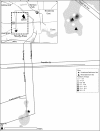Police Encounters Among Needle Exchange Clients in Baltimore: Drug Law Enforcement as a Structural Determinant of Health
- PMID: 26180948
- PMCID: PMC4539845
- DOI: 10.2105/AJPH.2015.302681
Police Encounters Among Needle Exchange Clients in Baltimore: Drug Law Enforcement as a Structural Determinant of Health
Abstract
Objectives: We piloted a monitoring mechanism to document police encounters around programs targeting people who inject drugs (PWID), and assessed their demographic predictors at 2 Baltimore, Maryland, needle exchange program (NEP) sites.
Methods: In a brief survey, 308 clients quantified, characterized, and sited recent police encounters. Multivariate linear regression determined encounter predictors, and we used geocoordinate maps to illustrate clusters.
Results: Within the past 6 months, clients reported a median of 3 stops near NEP sites (interquartile range [IQR] = 0-7.5) and a median of 1 arrest in any location (IQR = 0-2). Three respondents reported police referral to the NEP. Being younger (P = .009), being male (P = .033), and making frequent NEP visits (P = .02) were associated with reported police stops. Among clients reporting arrest or citation for syringe possession, Whites were significantly less likely than non-Whites to report being en route to or from an NEP (P < .001). Reported encounters were clustered around NEPs.
Conclusions: Systematic surveillance of structural determinants of health for PWID proved feasible when integrated into service activities. Improved monitoring is critical to informing interventions to align policing with public health, especially among groups subject to disproportionate levels of drug law enforcement.
Figures
References
-
- Taussig JA, Weinstein B, Burris S, Jones TS. Syringe laws and pharmacy regulations are structural constraints on HIV prevention in the US. AIDS. 2000;14(suppl 1):S47–S51. - PubMed
-
- Burris, S. Syringe possession laws map. Law Atlas: The Policy Surveillance Portal. 2015. Available at: http://lawatlas.org/query?dataset=paraphernalia-laws. Accessed June 30, 2015.
-
- Wodak A, Cooney A. Do needle syringe programs reduce HIV infection among injecting drug users: a comprehensive review of the international evidence Subst Use Misuse. 2006. 41(6):777–813. - PubMed
-
- Burris S. Syringe distribution laws map. Law Atlas: The Policy Surveillance Portal. 2014. Available at: http://lawatlas.org/query?dataset=syringe-policies-laws-regulating-non-r.... Accessed April 25, 2015.
Publication types
MeSH terms
Grants and funding
LinkOut - more resources
Full Text Sources
Research Materials
Miscellaneous


